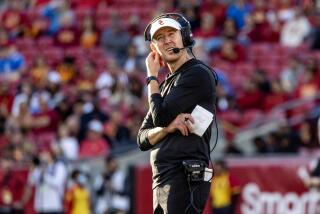THE FOSBURY FLOP : Scorned Method Is Taking Sport to New Heights
- Share via
The greatest Flop in track and field turned out to be a big hit.
It turned out to be one of those moments frozen in time, as in a still frame. But first, there were people chuckling and asking, “What’s wrong with this picture?”
Plenty, it seemed. Dick Fosbury, an Oregon State high jumper, had it backward, he was told. Learn the straddle method, they said. Or try the triple jump, his college coach, Berny Wagner, gently suggested.
Instead, Fosbury did the right thing. He kept jumping, pushing off his left foot, going up head first and back to the bar. And he kept jumping higher and higher. In 1968, he jumped to a then-Olympic record of 7 feet 4 1/4 inches in winning the gold medal at Mexico City.
That was the day the laughter stopped.
The day the Fosbury Flop became a technique, not a joke.
Javier Sotomayor, a lanky 6-foot-3 1/2 and 181 pounds, dressed in the Cuban national colors of red and white, was not thinking about the genesis of the Flop when he made his final approach toward the high jump bar last Saturday night in Sixto Escobar Stadium at San Juan, Puerto Rico. His concentration was centered on the bar high overhead. His energy was directed toward that mystical place way up there.
But when he flopped elegantly and safely into the landing pit moments later, the first to surpass the 8-foot barrier, he shared a kinship with Fosbury, now a 42-year-old surveyor from Ketchum, Ida.
“I wish I could have been there to see that,” he said. “I read it in the Sunday papers the next day and my eyes bugged out.”
What is that saying about once a track fan, always . . . ?
In 1978, Fosbury predicted an 8-foot leap within 10 years.
“I missed it by a year,” he said. “Still, it is hard to see. You put your hand up to an 8-foot ceiling. To realize that a guy can run and jump over that ceiling without touching it is a little bit unbelievable.”
Some would say much the same about the Fosbury Flop, which changed high jumping forever.
Sotomayor, who is entered in Sunday’s Jack in the Box Invitational at UCLA with U.S. record-holder Hollis Conway, may be one of the latest to spring forth, but it is difficult to forget the Flop.
Fosbury keeps it tucked away and lives in today’s world, he said. But he does not mind recounting those days in the ‘60s when everyone wanted a revolution but only an awkward Oregon teen-ager with a mind of his own gave them one.
As legends go, this one grew by leaps and bounds. All sorts of stories surrounding the Flop were contrived, even one suggesting that young Dick Fosbury began it after tripping and falling backward over the bar.
No such thing. Fosbury simply found a style of jumping that suited his spindly, awkward body as a sophomore at Medford High School.
Dean Benson, his high school coach who is retired and living in Medford, said he tried to convert Fosbury to the straddle method of jumping, which was prominent at the time. Before 1968, most jumpers used that style, lifting off one foot and rolling over the bar, head down.
Fosbury failed to grasp the method, though he practiced it time and again. By the end of the 1963 season, Benson gave in. He told Fosbury to use whatever style he wanted in the meet before the district championships.
“I won’t say I coached the Flop,” Benson said. “We gave Dick the opportunity to try it.”
In a meet at Grants Pass, Ore., the fearless Fosbury took off. He approached the bar from the left and jumped off his right foot. Using the old-fashioned scissors style--a glorified hurdle of the bar--Fosbury leaped 5-4, his best, without a miss.
The bar was raised to 5-6, and the Wizard of Foz, as he would later be known, was about to enter his own kingdom.
“I began to drop my shoulders, lift my hips trying to get my butt over the bar,” he said.
By the end of the meet, Fosbury had improved by four inches and scored a point in the meet.
Fans noticed the funny-looking jumper at the pit and converged on the scene. The higher he went, the larger the crowd grew.
Fosbury said he remembers hearing light laughter after his lay-back jumps, but he did not mind.
“That always helped to psych me up,” he said.
Said Benson: “He was a gangly, gawky kid who wanted to do something. Before that (meet), he wasn’t good enough to score a point in a junior varsity meet.”
Still, Fosbury hardly impressed Benson with the marked improvement.
“We told him, ‘Fine, but you’ll never go higher than 5-8,’ ” Benson said. “Then he got close to six feet and we decided we ought to change his style.”
But when he reverted to the straddle at Benson’s urging, Fosbury cleared only 5-5. It was uncomfortable for him, he said.
So during competition, he flopped. His body and skills strengthened during the next two years and he became one of Oregon’s best high school jumpers. Still, he was a novelty.
Benson said he was sitting in the stands at the state meet, watching his senior jumper, when he was approached by Bill Bowerman, then the revered track and field coach at the University of Oregon.
“He came over and sat down and said, ‘I’ve got to see this thing you have developed,’ ” Benson said.
Skepticism was rampant.
“Some people claimed it was illegal,” Benson said. “They said he took off with two feet on the ground, but he didn’t. He always took off on one foot.”
Others were concerned with safety.
“The administration said, ‘He’s going to kill himself,’ ” Benson said. “They said he would break his back, but if you looked closely, he wasn’t landing on the flat of his back.”
Not that he was always landing smoothly.
Benson recalled a time at Grants Pass when Fosbury hit his head on the wooden border of an old sawdust pit.
“I’ve had some hard landings,” Fosbury acknowledged. “In fact, I’ve landed totally out of the pit. I landed flat on my back and knocked the wind out of me.
“Those things happen. You have accidents when you’re trying to do something that is difficult.”
Benson, too, had concerns. So, he took some rubber foam and cut it into strips and placed them over the pit to help absorb the impact of Fosbury’s landings.
The Flop and foam rubber pits seemed to evolve simultaneously.
“Our high school was the first in the state to have them in 1964, but soon all the schools were using them,” Fosbury said.
Medical concerns followed Fosbury to Oregon State, where the Flop’s fame fueled further controversy.
Wagner, Fosbury’s coach at Oregon State and now national coach-coordinator for The Athletics Congress in Indianapolis, said doctors wanted to outlaw the Flop.
“A doctor in Virginia came out in a medical journal saying that every kid will break his neck, that flopping was dangerous,” Wagner said.
But the American Medical Assn.’s sports committee investigated the style and discovered it was no more hazardous than other physical endeavors, Wagner said.
Still, Wagner did not embrace he Flop when he first met Fosbury in 1965.
“A lot of people were laughing at him,” Wagner said. “I tried to convert him to the straddle method. We had two good straddlers on the team already.”
As a straddler, Fosbury jumped 5-11; with the Flop, 6-6 1/4.
Wagner remain unconvinced. He told Fosbury to try the triple jump his sophomore year. Instead, Fosbury lifted weights before the spring outdoor season and entered his first meet at Fresno State a stronger, more lithe athlete.
He cleared 6-10.
“I knew right then I didn’t need another triple jumper,” Wagner said. “I showed coaching genius by letting him jump.”
He also quit trying to stop the Flop.
“Dick expressed what a lot of people were trying to reach for back in the ‘60s,” Tom Greerty, a college friend of Fosbury’s, told Sports Illustrated. “Everyone was talking revolution, but there was still this herd mentality of copycats; one guy grew his hair long, so everyone else did. But the Foz, he had something truely different. The Foz was the only true revolutionary I ever met.”
That revolution became an international sensation at the 1968 Olympics when Fosbury edged teammate Ed Caruthers for the gold medal.
Fosbury entered the Olympic competition against 13 jumpers who had cleared seven feet, a height he had only dreamed of reaching. But the competitive spirit took hold and he improved 5 1/2 inches. The Flop earned its place in Olympic lore. “It was startling to a lot of people,” Fosbury said. “They felt I came out of nowhere.”
In fact, he had been jumping since he was 10. He said he watched junior high students jumping and imitated them after school.
His interest was such that his father, Doug, constructed a makeshift pit in the back yard. For a while, Fosbury perpetuated a story that he learned the curve approach because he had to run around a little cherry tree to reach the pit.
He now says that is not true.
In Ketchum, where he has lived for 11 years, he is part owner of a construction and engineering firm that is building running and biking paths through the forests.
He has embraced the mountain life style; he rides a mountain bike and road bike, loves Nordic skiing and says he soon will take up roller blades, the new sport of the outdoor-minded. His wife, Karen, and son Erich, 6, also join him.
“I live today in today’s world,” he said.
But it was only yesterday that the world flipped over the Flop.
More to Read
Go beyond the scoreboard
Get the latest on L.A.'s teams in the daily Sports Report newsletter.
You may occasionally receive promotional content from the Los Angeles Times.






